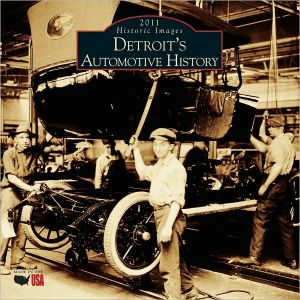

 |

|

The average rating for 2011 Detroit's Automotive History Wall Calendar based on 2 reviews is 3.5 stars.
Review # 1 was written on 2020-04-15 00:00:00 Robert English Robert EnglishQuick read, lots of historical pictures, fast read. Some cool stuff I learned: *There was a community of Japanese immigrants in Cincinnati in the 1890s, at least one of whom worked at the Rookwood pottery. *College Hill was originally nicknamed Pleasant Hill. *The original college that gave the hill its name- Farmer's College- was founded as an abolitionist alternative to Miami University. The book carefully describes Miami as "not pro-slavery, but pro-states' rights." Sure, Jan. The Farmer's College was located on the current site of Aiken HS, and its sister college was on the current site of the CCHMC campus. *In the 1800s, it took a whole day's walk to go the six miles from Cincinnati to College Hill because the road was so steep and rough. *The neighborhood was strongly abolitionist, and the Underground Railroad ran right up Hamilton Ave. The "Cincinnati 28" group of escaped slaves came up Mill Creek to a ravine on the east side of Hamilton Ave. They hid out behind the house on 5434 Hamilton Ave. The children of that home pretended to play in the backyard while smuggling food to the woodpile, where the escapees could obtain it unobserved. At nightfall, the owner of the house loaded the escapees under the false bottom of a wagon and transported them to the next stop: a storefront in Mt. Healthy. *John T. Crawford purchased farmland in College Hill before the Civil War. He served in the war, probably as a spy. After the war, his will converted the land to a home for aging African-American men, especially former slaves. Legend has it that Crawford was captured and imprisoned at the Libby POW camp during the war. The legend states that he escaped with the help of slaves, and they smuggled him all the way from Virginia to Cincinnati on foot, and that he created the home out of gratitude. The area included public baseball/soccer fields for years and is currently occupied by a library and an elementary school. *In the 1800s, there was a segregated school system for African-Americans in Cincinnati. They were integrated by the early 1900s. A class photo from 1910 shows that the integration was not entirely comfortable- African-Americans are positioned in the corners of the picture and the owner of the picture did not bother listing their names. Surprises: *I was surprised at how white this book was, considering that the neighborhood has been predominately African-American for decades. That's not entirely the book's fault. The area leadership was White well into the early 2000s, even though the constituency was largely African-American. *There was no serious effort to depict the economic hardship of the area- a problem that goes back roughly 100 years. I looked up a New Deal map that shows that the neighborhood was redlined in the 1930s. If you want to know more about a particular neighborhood's history, I recommend this series of books, with the knowledge that they are more motivated by nostalgia than thoroughness. |
Review # 2 was written on 2009-07-03 00:00:00 Yee May Leong Yee May LeongIt is difficult to know what words are the author's and where they are the sources he has used. This makes it hard to know whether the author himself holds pseudoarchaeological views (the 'Moundbuilders' and Native Americans being different people, for instance). |
CAN'T FIND WHAT YOU'RE LOOKING FOR? CLICK HERE!!!